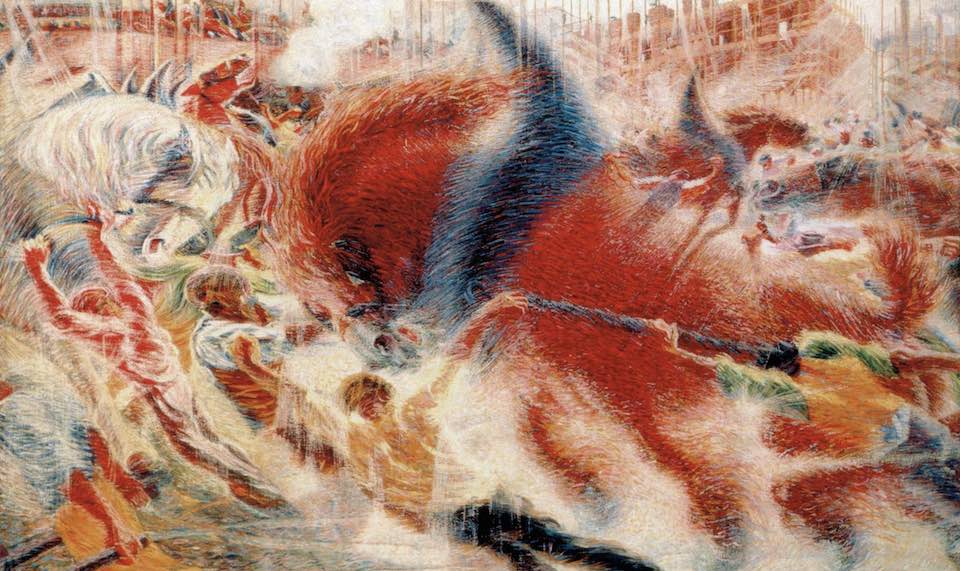
Long-read
The Manifesto of Futurism revisited
Marinetti’s explosive, utopian text continues to inspire – and discomfort.
Over a century has passed since the publication, in the Paris newspaper Le Figaro on 20 February 1909, of a frontpage article by Filippo Tommaso Marinetti which came to be known as the Manifesto of Futurism. Famous though this manifesto quickly became, it was just as quickly reviled as a document that endorsed violence, unbridled technology, and war itself as the ‘hygiene of the people’. Nevertheless, the 1909 manifesto remains the touchstone of what its author called l’arte di far manifesti, (‘the art of making manifestos’), an art whose recipe – ‘violence and precision’, ‘the precise accusation and the well-defined insult’ – became the impetus for all the manifesto-art that followed (1).
The context as well as the rhetoric of Marinetti’s astonishing document are worth exploring here. Consider, for starters, that the appearance of the manifesto, originally called Elettricismo or Dinamismo – Marinetti evidently hit on the more general title Futurismo while making revisions in December 1908 – was delayed by an unforeseen event that took place at the turn of 1909. On 2 January 1909, 200,000 people were killed in an earthquake in Sicily. As Günter Berghaus writes in a recent edition of Marinetti’s Critical Writings:
‘Marinetti realised that this was hardly an opportune moment for startling the world with a literary manifesto, so he delayed publication until he could be sure he would get frontpage coverage for his incendiary appeal to lay waste to cultural traditions and institutions. Several Italian newspapers published the manifesto in early February 1909 or reported its content. Toward the middle of February, Marinetti travelled to Paris, where in the Grand Hotel he composed the introductory paragraphs and submitted the full text to the editors of the prestigious newspaper Le Figaro.’ (2)
 Le Figaro frontpage
Le Figaro frontpageThe earthquake story is significant because it points to a central paradox that animates the 1909 manifesto as well as its Futurist successors. On the one hand, Marinetti’s Milan had been rapidly industrialised during the first decade of the century: it was now, as Berghaus notes, a city of banks, theatres, department stores and music halls, in which old buildings were rapidly demolished so that large roads could be cut through the urban centre. Streets were illuminated with powerful arc lamps and bore heavy traffic: buses, trams, automobiles, as well as the familiar bicycles, were everywhere. But natural disasters like the earthquake were reminders of the precarious foothold the new technology had in the Italian provinces. Then, too, there was as yet no cultural and artistic revolution to match la città nuova: Italian poetry, Marinetti’s included, continued to observe Romantic lyric conventions, while the Italian art world still looked to its glorious Classical and Renaissance past, suspicious of the ‘modernist’ art movements making news in France and Germany.
Marinetti met this tension head on by publishing his manifesto in what was the leading French newspaper, and by creating a narrative frame that would make his ‘revolutionary’ propositions palatable to his audience. Consider the opening:
‘We had stayed up all night, my friends and I, under hanging mosque lamps with domes of filigreed brass, domes starred like our spirits, shrinking like them with the prisoned radiance of electric hearts. For hours we had trampled our atavistic ennui into rich oriental rugs, arguing up to the last confines of logic and blackening many reams of paper with our frenzied scribbling.
‘An immense pride was buoying us up, because we felt ourselves alone at that hour, alone, awake, and on our feet, like proud beacons or forward sentries against an army of hostile stars glaring down at us from their celestial encampments. Alone with stokers feeding the hellish fires of great ships, alone with the black spectres who grope in the red-hot bellies of locomotives launched down their crazy courses, alone with drunkards reeling like wounded birds along the city walls.’ (3)
Could anything be more late-Romantic than that second paragraph, with its emphasis on the pride of the isolated protagonist, the metaphors of man as ‘proud beacon’ or ‘forward sentry against an army of hostile stars, glaring down at us from their celestial encampments’? And what could be more kitschy than the image of those stokers ‘feeding the hellish fires of great ships’, or the images of locomotives, with their ‘red-hot bellies’ and ‘drunkards reeling like wounded birds along the city walls’?
 The Laugh (1911), by Umberto Boccioni
The Laugh (1911), by Umberto BoccioniBut the larger picture is complicated by the ‘hanging mosque lamps’, ‘domes of filigreed brass’, and ‘rich oriental rugs’ that compose Marinetti’s decor. The exotic Eastern trappings (Marinetti grew up in Egypt and is describing his salon as it really was) give a fantastic cast to the imagery of locomotives and motorcars that follows. Indeed, the oriental rug becomes a kind of magic carpet, capable of carrying the group of young Futurists into the same realm as those ‘sleek’ planes, ‘whose propellers chatter in the wind’. The radiance of the mosque lamps merges with the ‘electric hearts’ of the new machines even as the ‘huge double-decker trams’ outside are ‘ablaze with colored lights’. Marinetti’s is thus no realistic description of ‘good factory muck’; on the contrary, the modern metropolis becomes a utopian dream-space where the timeless pleasures of the East merge with everything that is forward-looking and revolutionary. Accordingly, even nature appears in a glamorous, artificial light. As the Futurists rush out into the dawn, the narrator exclaims: ‘There’s nothing to match the splendour of the Sun’s red sword, slashing for the first time through our millennial gloom!’ The phallic Sun-sword quickly blends with the automobile’s steering wheel, ‘a guillotine blade that threatened my stomach’. Male power, in this aggressive fantasy, is all.
In the passage that follows, the spectre of death, substituting for the ‘ideal Mistress’ of Romantic lyric, is ‘domesticated’ in a sequence of animal images that carry the manifesto introduction’s longing for dehumanisation to its hyperbolic limits. Death ‘gracefully’ ‘holds out a paw’, and ‘once in a while’ makes ‘velvety caressing eyes at me from every puddle’. The poet spins his car around ‘with a frenzy of a dog trying to bite its tail’, his car, overturned in the ditch, is seen as a ‘big beached shark’, charging ahead on its powerful fins. Animal matter fuses with ‘metallic waste’ to create the setting wherein the actual manifesto can be performed.
The narrative frame thus prepares us for the violence, power, energy and sense of urgency of the manifesto itself. By the time the first proposition is made, Marinetti’s audience has suspended its disbelief, especially since the pronouncements to follow are all uttered by a ‘we’ rather than a more overtly egotistical ‘I’. Marinetti takes over many formulations from Nietzsche’s Zarathustra, but no longer is the individual subject in command. Rather, the ‘we’ are presented as representatives of the new masses, the factory workers and stokers, locomotive drivers and mechanics, who constitute the new ‘workers of the world’. Never mind that the workers of the world don’t live among mosque lamps and oriental rugs and don’t drive expensive cars or recall their Sudanese nurses, as does our poet. It seems, at least on the surface, that, in James Joyce’s words, Here Comes Everybody.
And so we absorb the formulae: ‘One. We intend to sing the love of danger, the habit of energy and fearlessness’; and, ‘Two. Courage, audacity and revolt will be essential elements of our poetry.’ Who can quarrel with these prescriptions, designed to help Marinetti’s readers move beyond lyric subjectivity and everyday discourse so as to participate in a meaningful project? The third proposition calls for the ‘feverish insomnia’ we have just witnessed, together with the ‘racer’s stride, the mortal leap, the punch and the slap’. This is a call to arms designed to awaken a listless, habit-bound populace from its long sleep. And so, to number four:
‘We say that the world’s magnificence has been enriched by a new beauty; the beauty of speed. A racing car whose hood is adorned with great pipes, like serpents of explosive breath – a roaring car that seems to ride on grapeshot – is more beautiful than the Victory of Samothrace.’
Half a century before the drug of the name came into use, the apotheosis of speed is celebrated by all the ‘fast’ men and women who are young enough to appreciate it. More important: note that the ‘we’ whose voice pronounces the fourth proposition has subtly become the coterie of right-minded artists who are Marinetti’s acolytes. What, after all, does the stoker or engine driver know about the 2nd-century BC marble statue at the top of the grand staircase in the Louvre? ‘We want to hymn the man at the wheel’, Marinetti declares, but it is not the man at the wheel who composes poetry or makes paintings. Never mind, because as number eight states: ‘Time and space died yesterday. We already live in the absolute, because we have created eternal, omnipresent speed.’
The apocalyptic note of these lines – a mix of bombast and shrewdness – has already been calculated to put the audience into a frenzy. It is now the moment to introduce number nine, the controversial war clause:
‘We will glorify war – the world’s only hygiene – miltarism, patriotism, the destructive gesture of freedom-bringers [le geste destructeur des anarchistes], beautiful ideas worth dying for, and scorn for woman.’
 Power Station (1914), by Antonio Sant’Elia
Power Station (1914), by Antonio Sant’EliaThe Marinetti who wrote these words in 1908 was an anarchist-socialist who wanted to rid Italy of the papacy and what was perceived to be the inertia and powerlessness of parliamentary democracy. The ‘destructive gesture’ cited above refers, so Berghaus tells us, to the ‘spectacular assassinations of Tsar Alexander II (1881) and King Umberto I of Italy (1900) and the anarchist bomb attacks that shook Paris in 1892-94’ – incidents that fascinated Marinetti when he was a young man studying in Paris. But anarchist doctrine didn’t offset Marinetti’s equally strong nationalism: he was enraged, for example, that the Italian-speaking South Tyrol was still a part of the Austro-Hungarian empire. As for the infamous ‘scorn for woman’, with which the passage ends, later Marinetti documents make clear that the reference is to ‘scorn’ for traditional bourgeois marriage arrangements, the conventional relationships between the sexes so beautifully satirised in Marinetti’s 1914 manifesto, Down with Tango and Parsifal. Indeed, in an interview made shortly after Le Figaro published the manifesto, Marinetti paid homage to the ‘magnificent elite of intellectual women’ in Paris vis-à-vis their less enlightened Italian counterparts.
The word ‘war’ has similarly been misunderstood: for the Marinetti of 1909, war meant primarily revolution, a utopian cleansing not unlike that prescribed by Marx and Engels in the Communist Manifesto. What ‘war’ would really mean when it was declared in 1914 was completely beyond his imagination. Rather, his focus in this and later manifestos is on the need ‘to destroy the museums, libraries, academies of every kind’, as if the destruction of museums and destruction of human lives in war were the same thing. The rationale behind these demands is weak, but the rhetoric is so powerful that the ‘we’ who listen are carried along by the manifesto’s own energy and speed. And the crux of the issue comes in the final proposition, number 11, which paves the way for the actual artworks made by Marinetti’s fellow futurists, Umberto Boccioni and Giacomo Balla, Carlo Carrà and Gino Severini, Antonio Sant’Elia and Luigi Russolo:
‘We will sing of great crowds excited by work, by pleasure, and by riot; we will sing of the multicoloured, polyphonic titles of revolution in the modern capitals; we will sing of the vibrant nightly fervour of arsenals and shipyards blazing with violent electric moons; greedy railway stations that devour smoke-plumed serpents; factories hung on clouds by the crooked lines of their smoke; bridges that stride the rivers like giant gymnasts, flashing in the Sun with a glitter of knives; adventurous steamers that sniff the horizon; deep-chested locomotives whose wheels paw the tracks like the hooves of enormous steel horses bridled by tubing; and the sleek flight of planes whose propellers chatter in the wind like banners and seem to cheer like an enthusiastic crowd.’
The imagery of this visionary passage has been anticipated from the first page of Marinetti’s narrative: the radiance of electric hearts looks ahead to the ‘violent electric moons’, the ‘splendour of the Sun’s red sword’ to the bridges ‘flashing in the Sun with a glitter of knives’, and so on. ‘Violence and precision’, in this context, also demand economy. Hyperbole works only when it is accompanied by speed. No wonder, then, that Marinetti’s prescriptions were soon realised in specific paintings. Boccioni’s The City Rises (1910), for example, carries out the Marinettian programme in uncanny ways. Here is the modern city seen as violent, colourful, frenzied, electrically charged space, in which vibrating forms dissolve and overlap. The great draft horse on the left surges forward, men are seen straining against it, while shafts of light dissolve solid shapes into fluid, flaming colour strokes. At centre right, a gigantic steed, whose collar metamorphoses into a blue propeller blade slashing the air, throws space into turmoil, while the factory chimneys and building scaffolds rise at a receding diagonal behind it. Here and in related Boccioni paintings like The Street Enters the House (1911) are the ‘great crowds excited by work, by pleasure’, the ‘multicoloured, polyphonic tides’ of agitated life in the modern capitals, the blazing electric lights, smoke, glitter of steel, and above all speed, soon to be abstracted by Balla in a painting like the Swifts (1913). And the bridge ‘flashing in the Sun with a glitter of knives’ surely inspired the shining knife-like girders of Joseph Stella’s Brooklyn Bridge (1919-1920).
After the crescendo of its final numbered proposition, the manifesto turns more personal, more comic and good-humoured. Questioning the necessity of museums and comparing them to cemeteries, Marinetti now bombards his captive audience with questions. Clowning playfully, he calls up the ‘gay incendiaries’ who will ‘set fire to the library shelves’ and ‘turn aside the canals to flood the museums’. And Marinetti admits that his is a young person’s sport: ‘The oldest of us is 30: so we have at least a decade for finishing our work. When we are 40, other younger and stronger men will probably throw us in the wastebasket like useless manuscripts – we want it to happen!’
Within the decade, Boccioni and Sant’Elia would be dead, killed in the First World War, and the Futurist cénacle of the 1910s would have lost its raison d’être. The call for speed and violence, for overturning the world, was to be answered in sinister ways Marinetti could never have anticipated. But then, as he declares at the end of his 1909 manifesto, ‘We don’t want to understand’. Art, in his view, must move beyond understanding, beyond reason, to create its own mode of being.
 Brooklyn Bridge (1919-20), by Joseph Stella
Brooklyn Bridge (1919-20), by Joseph StellaWhat makes the Manifesto of Futurism such a poignant document is thus its place on the cusp of an era it has largely misapprehended. The ‘great crowds excited by work, by pleasure’ turn out to be the masses of soldiers dying in the trenches, and the desired ‘revolution’ paves the way for the fascism of the 1920s. Yet we should remember that utopianism, the projection of an idealised future that may well have nothing to do with reality – is at the very heart of the manifesto form – a form rooted, not in the future it conceives of so boldly, but in the immediate present of its author and audience. The ‘love of danger’, the ‘habit of energy’, the ‘beauty of speed’: these make up a complex that gives the present moment its pungency and charm. And the reader, who participates in the moment of declamation along with the poet, has no time to ask questions or draw inferences. The manifesto’s dramatic, breathless ‘speedy’ prose, embodying the very qualities it celebrates, becomes an end in itself.
As a rhetorical feat, the Manifesto of Futurism is thus remarkable. But rhetoric and poetic are not necessarily equivalent, as no one understood better than one of Marinetti’s most discerning critics, Gertrude Stein. In her subtle and devastating poem portrait, ‘Marry Nettie’ (4), written during her sojourn, with Alice B Toklas, in Mallorca during the war that was to be the ‘hygiene of the people’, Stein replaces Marinetti’s bombast, his pithy pronouncement, and reliance on onomatopoeic sound effects with a subtle wordplay and dislocation of syntax that may be said to constitute a kind of anti-manifesto of her own. The ‘Principle calling’ and aggression (‘artillery is very important in war’) Stein attributes to Marinetti give way to a calculated withdrawal into the private sphere, where two women try to live their day-to-day life as best they can in the context of the chaos around them.
In the middle of her fractured narrative, Stein remarks, ‘We took a fan out of a man’s hand’. The fan is, of course, a traditional emblem of femininity, but here, the fan, carefully removed from male control, morphs comically into an electric fan. ‘We will also get a fan’, the narrator has already declared to her companion. ‘We will have an electric one.’ Electricity, claimed by the Futurist cenacle as its domain, thus becomes, by a sleight of hand, a female property – a property that has its peacetime uses. Or so ‘Marry Nettie’ implies.
Does Stein’s oblique and brilliant anti-manifesto thus present a credible challenge to Marinetti’s own? Yes and no. Yes, in that her implicit critique of Marinettian violence is certainly preferable to the call for ‘war’ as the ‘hygiene of the people’. But what about audience? Almost a century after it was written, Stein’s brilliant but difficult ‘Marry Nettie’ remains an obscure poetic composition, rarely reprinted and unknown even to some of the poet’s enthusiastic readers. For sheer audience impact, Marinetti’s manifesto retains its aura, however distasteful its extractable ideas. It offers ‘solutions’ whereas Stein’s text dramatises the need for quietude, daily routine and individual fulfillment. How, in her scheme of things, is the ‘war’ Marinetti advocates to be avoided? Stein has no answer. But, as Blake put it, ‘Without contraries is no progression’: we need both Marinetti and Marry Nettie if we are to understand the aporias of modernism.
Marjorie Perloff is professor emerita of English at Stanford University and Florence R Scott professor of English at the University of Southern California. She is the author of many books, including: Postmodern Genres (1989); Frank O’Hara: Poet Among Painters (1998); Differentials: Poetry, Poetics, Pedagogy (2004); and Poetics in a New Key: Interviews and Essays (2014).
This is an edited version of an essay that first appeared in Rett Kopi.
Picture: The City Rises by Umberto Boccioni (1910).
Footnotes:
(1) See The Futurist Moment: Avant-Garde, Avant-Guerre, and the Language of Rupture, by Marjorie Perloff, University of Chicago Press, 2004, pp81-82
(2) Critical Writings, by FT Marinetti, edited by Gunter Berghaus, Farrar, Straus and Giroux, 2006
(3) This and all citations from the manifesto are taken from Let’s Murder the Moonshine: The Selected Writings of FT Marinetti, edited and translated by RW Flint, Sun & Moon Press, 1991, pp47-52
(4) I discuss ‘Marry Nettie’ vis-à-vis Marinetti more fully in Wittgenstein’s Ladder: Poetic Language and the Strangeness of the Ordinary, University of Chicago Press, 1996, pp 98-112
To enquire about republishing spiked’s content, a right to reply or to request a correction, please contact the managing editor, Viv Regan.





Comments
Want to join the conversation?
Only spiked supporters and patrons, who donate regularly to us, can comment on our articles.